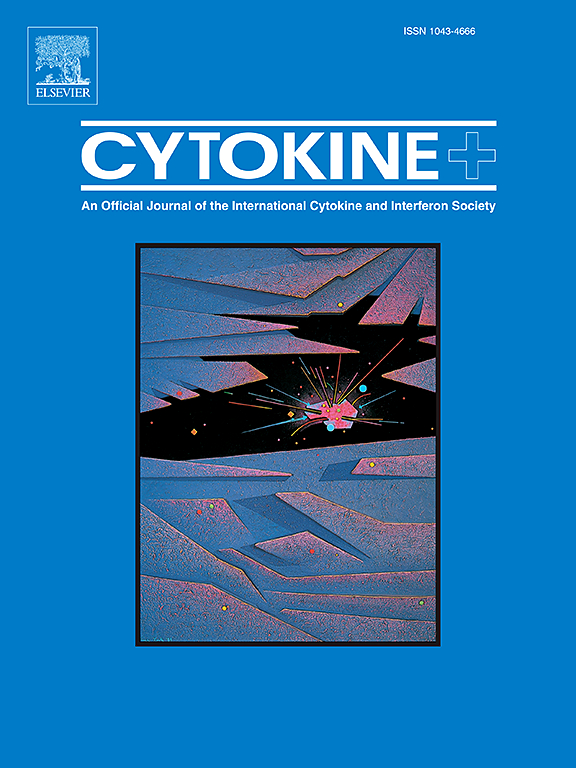循环炎症蛋白与不同类型脑炎风险之间的因果关系:双样本孟德尔随机研究。
IF 3.7
3区 医学
Q2 BIOCHEMISTRY & MOLECULAR BIOLOGY
引用次数: 0
摘要
背景:细胞因子是免疫反应的强效分子。它们在炎症部位发挥作用,并在血液中循环。然而,有关脑炎和循环炎症蛋白的研究却很少:本研究采用孟德尔随机法(MR)探讨了 91 种循环炎症蛋白对 3 种不同类型脑炎的潜在因果效应。研究采用了 Steiger、MR-Egger、加权中位数和逆方差加权(IVW)方法对因果效应进行了检验。IVW 方法主要用于结果解释。此外,我们还进行了敏感性分析,包括异质性评估、水平多效性和 "Leave-one-out "技术:我们对 91 种循环炎症蛋白与三种脑炎的因果关系进行了 MR 分析。结果表明,与病毒性脑炎有潜在因果关系的炎症因子是caspase 8、C-X-C motif趋化因子6、白细胞介素-10、白细胞介素-15受体亚基α、白细胞介素-7和TNF-β。可能与急性播散性脑脊髓炎有关的炎症因子有:β-神经生长因子、胱抑素 D、白细胞介素-7、潜伏期相关肽转化生长因子β1 和神经营养素-3。与自身免疫性脑炎有潜在因果关系的炎症因子包括 C-C motif 趋化因子 25、肝细胞生长因子、潜伏期相关肽转化生长因子 beta 1、程序性细胞死亡 1 配体 1、磺基转移酶 1A1 和肿瘤坏死因子:这一发现确定了某些循环炎症因子对三种脑炎易感性的潜在因果效应。结论:这一发现确定了某些循环炎症因子对三种脑炎易感性的潜在因果关系,同时也表明了调节这些细胞因子水平的治疗潜力。为进一步研究提供了依据。本文章由计算机程序翻译,如有差异,请以英文原文为准。
Causal relationship between circulating inflammatory proteins and risk of different types of encephalitis: A two-sample Mendelian randomization study
Background
Cytokines are potent molecules of the immune response. They act at the site of inflammation and circulate in the bloodstream. However, there are few studies on encephalitis and circulating inflammatory proteins.
Methods
In this study, Mendelian randomization (MR) was used to explore the potential causal effect of 91 circulating inflammatory proteins on 3 different types of encephalitis. Causal effects were examined using Steiger, MR-Egger, weighted median, and inverse variance weighting (IVW) methods. IVW methods were primarily used for results interpretation. In addition, sensitivity analyses were performed, including assessment of heterogeneity, horizontal pleiotropy, and Leave-one-out techniques.
Results
We subjected 91 circulating inflammatory proteins to MR analysis of causality with each of the three types of encephalitis. The results suggested that the inflammatory factors with a potential causal relationship with viral encephalitis were caspase 8, C-X-C motif chemokine 6, interleukin-10, interleukin-15 receptor subunit alpha, interleukin-7, and TNF-beta. Inflammatory factors potentially causally associated with acute disseminated encephalomyelitis are beta-nerve growth factor, cystatin D, interleukin-7,
Latency-associated peptide transforming growth factor beta 1,and neurotrophin-3.Inflammatory factors potentially causally associated with autoimmune encephalitis are C–C motif chemokine 25, hepatocyte growth factor, latency-associated peptide transforming growth factor beta 1, programmed cell death 1 ligand 1, sulfotransferase 1A1, and tumor necrosis factor.
Conclusion
This finding identifies potential causal effects of certain circulating inflammatory factors on susceptibility to three types of encephalitis. It also suggests the therapeutic potential of modulating the levels of these cytokines. A basis for further research is provided.
求助全文
通过发布文献求助,成功后即可免费获取论文全文。
去求助
来源期刊

Cytokine
医学-免疫学
CiteScore
7.60
自引率
2.60%
发文量
262
审稿时长
48 days
期刊介绍:
The journal Cytokine has an open access mirror journal Cytokine: X, sharing the same aims and scope, editorial team, submission system and rigorous peer review.
* Devoted exclusively to the study of the molecular biology, genetics, biochemistry, immunology, genome-wide association studies, pathobiology, diagnostic and clinical applications of all known interleukins, hematopoietic factors, growth factors, cytotoxins, interferons, new cytokines, and chemokines, Cytokine provides comprehensive coverage of cytokines and their mechanisms of actions, 12 times a year by publishing original high quality refereed scientific papers from prominent investigators in both the academic and industrial sectors.
We will publish 3 major types of manuscripts:
1) Original manuscripts describing research results.
2) Basic and clinical reviews describing cytokine actions and regulation.
3) Short commentaries/perspectives on recently published aspects of cytokines, pathogenesis and clinical results.
 求助内容:
求助内容: 应助结果提醒方式:
应助结果提醒方式:


